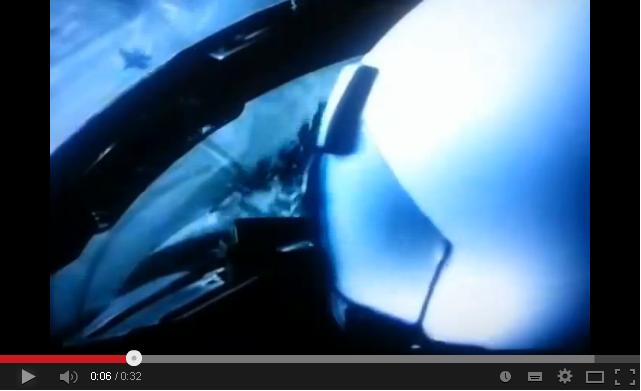It looks like you're using an Ad Blocker.
Please white-list or disable AboveTopSecret.com in your ad-blocking tool.
Thank you.
Some features of ATS will be disabled while you continue to use an ad-blocker.
share:
originally posted by: Clairaudience
originally posted by: crazyewok
Only problem is if you launch a nuclear pulse ship the bangs so big the whole world will know you launched one.
It actually would be very inefficient to use a nuclear pulse engine to get the spacecraft into orbit. We have better ways to do that, using less fuel and obviously being a lot more low-profile. But using such an engine in space can accelerate you to insanely fast speeds in a very short amount of time.
Not really chem rockets can only really launch a 100 tons at a time. And just look at the price tag on the Saturn V rocket that could lift that!
NPP could get 8 million tons into orbit. The cost of getting 10,000 ton in orbit would be alot less than if using the chems.
a reply to: eNumbra
Please don't get me wrong, I DO believe you. I agree that he was talking about what he liked as a child. I was just bringing up the point that if you watch the commercial alone, with out going to the internet or wiki to investigate further into the significance of the statement it is pretty open to interpretation. At least in my opinion. I was just being precise and arguing the specifics/semantics of the commercial alone, without any accompanying details like his BIO which would explain it.
Hope we are on the same page now, I am getting tired of talking about it No sense in us both repeating ourselves over and over.
Please don't get me wrong, I DO believe you. I agree that he was talking about what he liked as a child. I was just bringing up the point that if you watch the commercial alone, with out going to the internet or wiki to investigate further into the significance of the statement it is pretty open to interpretation. At least in my opinion. I was just being precise and arguing the specifics/semantics of the commercial alone, without any accompanying details like his BIO which would explain it.
Hope we are on the same page now, I am getting tired of talking about it No sense in us both repeating ourselves over and over.
Maaaayn, I remember the good old days when they used to entice you to join up with the promise of Skiing.
originally posted by: sputniksteve
a reply to: eNumbra
I was just being precise and arguing the specifics/semantics of the commercial alone, without any accompanying details like his BIO which would explain it.
Fair enough, I may be too used to easily picking up more complex writing to even see a semantic issue.
i saw the other topic too...?

real or not.. it seems someone out there wants us to think they's got starships
stealth technology that'd make george lucas cream in his pies?
eventually "something" like this is going to happen.. why not now? we've been hearing about it for years..
ah well.. back to the spice mines

real or not.. it seems someone out there wants us to think they's got starships
stealth technology that'd make george lucas cream in his pies?
eventually "something" like this is going to happen.. why not now? we've been hearing about it for years..
ah well.. back to the spice mines
a reply to: sputniksteve
I think its just advertising to be honest. Thats a pretty powerful commercial, with powerful images and an uplifting message for aspiring young men like myself who dream of being a pilot. Im not even gonna lie, when i see that commercial, in that instant i wanna go join the airforce, but then i realize im probably not the right guy to be selected for being a starship pilot, or even to be selected to fly a prop aircraft for the airforce.
i want in on the super top secret stuff, but admitting that probably kills any chance of me ever getting selected...i promise i wont tell anyone, guys! heck, fake my death or disappearance, just give me a chance to fly a star ship lol
I think its just advertising to be honest. Thats a pretty powerful commercial, with powerful images and an uplifting message for aspiring young men like myself who dream of being a pilot. Im not even gonna lie, when i see that commercial, in that instant i wanna go join the airforce, but then i realize im probably not the right guy to be selected for being a starship pilot, or even to be selected to fly a prop aircraft for the airforce.
i want in on the super top secret stuff, but admitting that probably kills any chance of me ever getting selected...i promise i wont tell anyone, guys! heck, fake my death or disappearance, just give me a chance to fly a star ship lol
a reply to: Zaphod58
politics groundside are just a farce to keep the masses occupied and looking down.
russia, china, india, EU, USA, etc. etc. - all major powers are in cahoots, a space program beyond launching probes, landers, and tiny crews into orbit, would undeniably take the combined forces of all the nations of earth, or atleast the most populous and wealthy.
politics groundside are just a farce to keep the masses occupied and looking down.
russia, china, india, EU, USA, etc. etc. - all major powers are in cahoots, a space program beyond launching probes, landers, and tiny crews into orbit, would undeniably take the combined forces of all the nations of earth, or atleast the most populous and wealthy.
Someone else first posted this in this thread, so I am not trying to take credit for it but is a damn interesting read and very relevant to this
discussion. Just in case anyone missed it or decided not to check it out the first time. I implore you to check it out.
www.abovetopsecret.com...
www.abovetopsecret.com...
Well...
Now that was a read and a half. Some of the questions in there are eerily accurate,
Solar Warden - wasn't THE projects name, it was and is a weapons name. A huge retractable / inflatable system that gathered up energy from the sun to power its rail gun. (The reason for alack of nuclear power plant aboard was to defeat Soviet sensors that were amazingly accurate at sniffing out EM fields - this sprang from their desire to be able to determine false from real ICBM war heads)
When it goes 'cold' it presents a conical shield towards the ground. When the war fighting command is given, voila, powers back up, gathers in the rays and starts seeking.
Now that was a read and a half. Some of the questions in there are eerily accurate,
Solar Warden - wasn't THE projects name, it was and is a weapons name. A huge retractable / inflatable system that gathered up energy from the sun to power its rail gun. (The reason for alack of nuclear power plant aboard was to defeat Soviet sensors that were amazingly accurate at sniffing out EM fields - this sprang from their desire to be able to determine false from real ICBM war heads)
When it goes 'cold' it presents a conical shield towards the ground. When the war fighting command is given, voila, powers back up, gathers in the rays and starts seeking.
edit on 14-7-2014 by Astr0 because: (no reason given)
I rewatched the youtube very slowly playing and pausing very quickly as I went and I tried to capture what was displayed on the screen when certain
words were spoken ... and this is the result of the screen captures I took ...
"Airplane"

"Jet"

"Rocket"

"Spaceship"

"Starship" [two screen grabs]
1

2

And then it quickly cuts to this frame ...

and the commercial continues on from there!
Its my opinion that the pictures are of the following ...
Airplane: combat aircraft such as the JSF.
Jets: Cockpit view looking out of jet fighter from next to pilots helmet.
Rocket: The Shuttle Launch Vehical
Spaceships: The Shuttle with cargo bay door open and HABLAB present.
Starships: 1st Nuke detonation flash followed by another 2nd Nuke detonation flash slightly away from the 1st one.
I am going to stop here and declare that is ORION!
And then that is all quickly covered over by the long after shot of in cockpit looking back from in front of pilot with wing visible.
Now as for what Zaphod said ...
Project Orion (nuclear propulsion)

Further reading on nuke tests in space ... Operation Fishbowl
"Airplane"

"Jet"

"Rocket"

"Spaceship"

"Starship" [two screen grabs]
1

2

And then it quickly cuts to this frame ...

and the commercial continues on from there!
Its my opinion that the pictures are of the following ...
Airplane: combat aircraft such as the JSF.
Jets: Cockpit view looking out of jet fighter from next to pilots helmet.
Rocket: The Shuttle Launch Vehical
Spaceships: The Shuttle with cargo bay door open and HABLAB present.
Starships: 1st Nuke detonation flash followed by another 2nd Nuke detonation flash slightly away from the 1st one.
I am going to stop here and declare that is ORION!
And then that is all quickly covered over by the long after shot of in cockpit looking back from in front of pilot with wing visible.
Now as for what Zaphod said ...
Project Orion (nuclear propulsion)

Image of the smallest Orion vehicle extensively studied, which could have had a payload of around 100 tonnes in an 8 crew round trip to Mars. On the left, the 10 meter diameter Saturn V "Boost-to-orbit" variant, requiring in-orbit assembly before the Orion vehicle would be capable of moving under its own propulsion system. On the far right, the fully assembled "lofting" configuration, in which the spacecraft would be lifted high into the atmosphere before pulse propulsion began. As depicted in the 1964 NASA document "Nuclear Pulse Space Vehicle Study Vol III - Conceptual Vehicle Designs and Operational Systems."
Further reading on nuke tests in space ... Operation Fishbowl
a reply to: DietJoke
Dude, nice work. That Airplane screen shot looks like the Raptor to me. Based on my very, VERY civilian expertise. Anyone else see that? Not that it is important, just flexing my mad airplane spotting skills. The other ones are very interesting, I like the Orion interpretation. If they were in fact going for a theme then what else could they put up for Starship?
Dude, nice work. That Airplane screen shot looks like the Raptor to me. Based on my very, VERY civilian expertise. Anyone else see that? Not that it is important, just flexing my mad airplane spotting skills. The other ones are very interesting, I like the Orion interpretation. If they were in fact going for a theme then what else could they put up for Starship?
a reply to: Sammamishman
Katchow, I am now an expert. Compared to my wife and son at least. Putting Airplane shadow spotter on my resume now.
Katchow, I am now an expert. Compared to my wife and son at least. Putting Airplane shadow spotter on my resume now.
new topics
-
Disney’s Snow White | Official Trailer | In Theaters March 21
Movies: 1 hours ago -
UnitedHealthcare CEO Brian Thompson shot dead in Midtown Manhattan, masked gunman at large
Other Current Events: 1 hours ago -
More NY Justice System Corruption
Social Issues and Civil Unrest: 5 hours ago
top topics
-
More NY Justice System Corruption
Social Issues and Civil Unrest: 5 hours ago, 16 flags -
US spent $151 BILLION on illegal immigration in 2023 alone: DOGE
US Political Madness: 17 hours ago, 12 flags -
Liven things up with some COMMUNITY!
General Chit Chat: 17 hours ago, 9 flags -
CIA Whistleblower Kevin Shipp claims CIA was involved in MH370's disappearance
General Conspiracies: 17 hours ago, 8 flags -
Would Democrats Be in Better Shape if They Had Replaced Joe Biden with Kamala Harris in July 2024.
US Political Madness: 12 hours ago, 7 flags -
President Biden is Touring Africa. Why?
Politicians & People: 17 hours ago, 6 flags -
UnitedHealthcare CEO Brian Thompson shot dead in Midtown Manhattan, masked gunman at large
Other Current Events: 1 hours ago, 6 flags -
Disney’s Snow White | Official Trailer | In Theaters March 21
Movies: 1 hours ago, 3 flags
active topics
-
Great Barrier Reef Attacks and Sinks New Zealand Frigate HMNZS Manawanui
Weaponry • 70 • : fringeofthefringe -
UnitedHealthcare CEO Brian Thompson shot dead in Midtown Manhattan, masked gunman at large
Other Current Events • 14 • : PorkChop96 -
Disney’s Snow White | Official Trailer | In Theaters March 21
Movies • 5 • : Athetos -
Alien warfare predicted for December 3 2024
Aliens and UFOs • 87 • : Arbitrageur -
Salvatore Pais confirms science in MH370 videos are real during live stream
General Conspiracies • 89 • : b0kal0ka -
President Biden is Touring Africa. Why?
Politicians & People • 15 • : Coelacanth55 -
US spent $151 BILLION on illegal immigration in 2023 alone: DOGE
US Political Madness • 5 • : marg6043 -
Would Democrats Be in Better Shape if They Had Replaced Joe Biden with Kamala Harris in July 2024.
US Political Madness • 24 • : WeMustCare -
CIA Whistleblower Kevin Shipp claims CIA was involved in MH370's disappearance
General Conspiracies • 16 • : b0kal0ka -
-@TH3WH17ERABB17- -Q- ---TIME TO SHOW THE WORLD--- -Part- --44--
Dissecting Disinformation • 3481 • : angelchemuel
